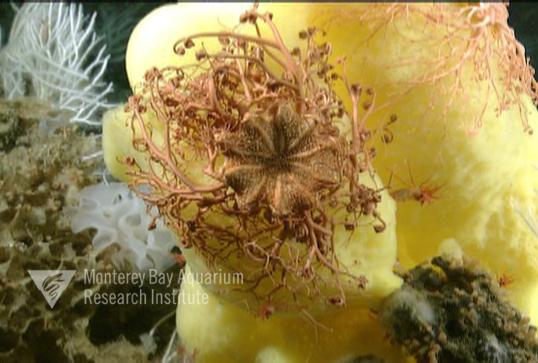Description
General:
Five rays extend from the central disc and branch dichotomously. Central disc bears 10 prominent spoke-like plates. The finely bifurcated rays are covered in small hooks and are often held like a basket oriented into the currents. Central disc is brown in color while the rays may be tan, beige, orange-red, pink or even white.
Size:
To 14 cm central disc diameter, to at least 60 cm total diameter.
Reproduction:
Spawns annually, from June to November.
Geographic Information
Ocean range (global):
North Pacific Ocean, from Bering Sea to Mexico and Japan, and North Atlantic Ocean.
Habitat description:
Benthic, rocky substrate and soft sediments with boulders or organic substrate.
Published depth range:
10 - 2000 m
Additional Information
Color:
Brown, tan, beige, orange-red, pink or even white.
Diet:
Small benthic crustaceans, zooplankton (including chaetognaths, fish larvae and jellies).
Looks like:
Asteronyx.
Key visual features:
Finely branched rays extending from central disc.
References
Encyclopedia of LifeTree of Life
World Register of Marine Species
National Center for Biotechnology Information
Müller, J. and F.H. Troschel (1842). System der Asteriden. 1. Asteriae. 2. Ophiuridae. Vieweg: Braunschweig. xxx+134 pp. 12 pls.
Lambert, P. and W.C. Austin (2007). Brittle stars, sea urchins and feather stars of British Columbia, southeastern Alaska and Puget Sound. Victoria, Canada: Royal British Columbia Museum.
Patent, D.H. (1970). Life history of the basket star, Gorgonocephalus eucnemis (Müller & Troschel). Ophelia, 8: 145-159.
Herrero-Pérezrul, M.D., R. Granja-Fernández, M. Hoyos-Padilla and H. Reyes-Bonilla (2014). New record of the basket star Gorgonocephalus eucnemis (Ophiuroidea: Gorgonocephalidae) at the Pacific coast of Mexico. Marine Biodiversity Records, 7: e33.
Citation:
Gorgonocephalus eucnemis
(Mueller and Troschel, 1842) Deep-Sea Guide (DSG) at http://dsg/mbari.org/dsg/view/concept/Gorgonocephalus%20eucnemis. Monterey Bay Aquarium Research Institute (MBARI). Consulted on 2025-12-23.

 Click here for a larger image.
Click here for a larger image.
